Permaculture companion plants for Pot marigold
| Image | Name | Data | Description | Actions |
|---|---|---|---|---|
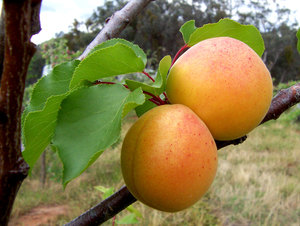
|
Apricot |
4-8
Perennial
Full sun, Partial sun/shade
Moist
Light (sandy), Medium
Deciduous
9.0
Trees
Adhesive, Dye, Gum, oil, Lumber, Espalier
true
Fruit, Seed
https://en.wikipedia.org/wiki/Prunus_armeniaca
Medium
Rosaceae
true
Oil, Gum
https://pfaf.org/User/Plant.aspx?LatinName=Prunus armeniaca
China North-Central, China South-Central, Inner Mongolia, Kazakhstan, Kirgizstan, Kriti, Manchuria, Qinghai, Uzbekistan, Xinjiang
Afghanistan, Albania, Algeria, Bulgaria, California, Central European Rus, Colorado, Corse, Cyprus, East European Russia, East Himalaya, France, Germany, Greece, Hungary, Idaho, Illinois, Iowa, Iran, Italy, Kansas, Korea, Krym, Lebanon-Syria, Libya, Michigan, Missouri, Montana, Morocco, New Mexico, New South Wales, North Caucasus, Oregon, Pakistan, Pennsylvania, Portugal, Queensland, Romania, Sardegna, South Australia, South European Russi, Tadzhikistan, Transcaucasus, Tunisia, Turkey, Turkey-in-Europe, Turkmenistan, Ukraine, Utah, Virginia, Washington, West Himalaya, Yugoslavia
https://powo.science.kew.org/taxon/urn:lsid:ipni.org:names:729463-1
|
The apricot is a tree native to China and Central Asia. It typically grows to be about 20-30 feet tall and has a spreading, round canopy. The leaves are oval-shaped and about 2-4 inches long, with a serrated edge and a glossy green surface. The flowers are white or pink and have five petals. The fruit is a drupe, similar in appearance to a peach, with a smooth, orange skin and a fleshy interior. Apricots are known for their sweet flavor and are often used in jams, jellies, and other preserves. The fruit can also be eaten fresh or dried. The seed, or pit, of the apricot contains a small amount of cyanide and should not be eaten. Apricots prefer a warm, sunny climate and well-draining soil. They are sensitive to frost and can be damaged by cold temperatures. To successfully grow apricots, they should be planted in an area with full sun exposure and watered regularly. Apricots have a number of uses beyond their delicious fruit. The wood of the tree is often used for smoking meats, and the leaves can be used as a natural insecticide. In traditional medicine, apricot oil has been used to treat a variety of ailments. |
Show
Edit |
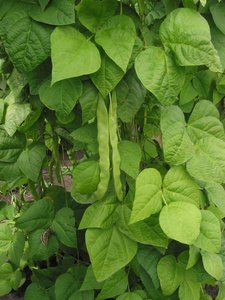
|
Common bean |
2-11
Annual
Full sun
Moist
Light (sandy), Medium, Heavy (clay)
2.0
Vines
Biomass, Dye, antifungal, Nitrogen fixer
true
Leaves, Seed, Seedpod
Seed - transplant, Seed - direct sow
https://en.wikipedia.org/wiki/Phaseolus_vulgaris
Pole bean, Climbing bean, French bean, Bush bean, Dwarf bean, Kidney bean, Green bean
Fabaceae, Leguminosae
Stangenbohne
https://pfaf.org/User/Plant.aspx?LatinName=Phaseolus vulgaris
16-18°c (70-80°f)
6.0-6.8
2.5 cm
16cm
4-10 days
45-85
Fast
Sperzieboon
Costa Rica, Guatemala, Honduras, Mexico Central, Mexico Gulf, Mexico Northeast, Mexico Northwest, Mexico Southeast, Mexico Southwest, Nicaragua, Panamá
Altay, Amur, Andaman Is., Angola, Argentina Northeast, Argentina Northwest, Assam, Baltic States, Bangladesh, Belarus, Bolivia, Bulgaria, Buryatiya, Cameroon, Cayman Is., Central European Rus, Chad, Chita, Colombia, Comoros, Cuba, Czechoslovakia, Dominican Republic, East European Russia, East Himalaya, Ecuador, Ethiopia, Guinea, Gulf of Guinea Is., Haiti, Illinois, India, Iraq, Irkutsk, Jamaica, Jawa, Kazakhstan, Kenya, Khabarovsk, Kirgizstan, Korea, Krasnoyarsk, Kuril Is., Leeward Is., Malaya, Marianas, Maryland, Mongolia, Myanmar, Nepal, New Guinea, New York, Nicobar Is., Nigeria, North Caucasus, North European Russi, Northwest European R, Pakistan, Peru, Philippines, Primorye, Puerto Rico, Queensland, Rwanda, Sakhalin, Senegal, South European Russi, Sri Lanka, Tadzhikistan, Tanzania, Thailand, Togo, Transcaucasus, Trinidad-Tobago, Turkmenistan, Tuva, Uganda, Ukraine, Uzbekistan, Venezuela, Vietnam, Wake I., West Himalaya, West Siberia, Yakutskiya, Zambia, Zaïre
2-4 weeks before last frost
1 week after last frost, 12-14 weeks before first frost
3-5 years
0.4
https://powo.science.kew.org/taxon/urn:lsid:ipni.org:names:514191-1
Coffee, Condiment
|
This entry describes all varieties of the common bean. This includes vining and bush/darf variaties and can have different names depending on their style of growths (see alternate names). These include the kidney bean, the navy bean, the pinto bean, the French bean and the wax bean The common bean, scientific name Phaseolus vulgaris, is a herbaceous annual plant native to the Americas, specifically the regions extending from the southwestern United States to South America. It is a member of the Fabaceae (legume) family. The common bean has a range of different appearances, depending on the variety. Most varieties have a simple, erect stem that grows to a height of 20-60 cm. The leaves are typically green and consist of 3-5 oblong leaflets. The flowers are small and white, pink, or purple in color. The fruit is a legume, which contains the seeds. The common bean is typically a small plant, but some varieties can grow to be quite large, reaching heights of up to 2 meters. The plant grows relatively quickly, with the growing season typically lasting between 60-100 days. The common bean prefers well-drained soil and full sun, but can also grow in partial shade. It is sensitive to frost and should be planted after the last frost date in the spring. To cultivate the common bean successfully, a grower may need to ensure that the soil is adequately fertilized and provide support for the plant to climb, if necessary. The common bean is edible, with the seeds and the young pods being the most commonly consumed parts. The seeds can be cooked and eaten as a protein-rich vegetable, and the young pods can be eaten as a green vegetable. The edible parts can be stored after harvest by drying the seeds or by preserving the young pods in vinegar or oil. The common bean has many uses beyond being a food source. The plant can fix nitrogen in the soil, improving its fertility and making it a useful companion plant for other crops. The dried leaves and stems of the common bean can be used as mulch or as a source of organic matter. In some cultures, the fibers from the stems are used to make ropes or other weaving materials. Additionally, the plant has been used medicinally to treat a variety of ailments. The common bean is also valuable for wildlife. The flowers attract bees and other pollinators, and the plant provides food for a variety of insects, birds, and small mammals. ### Links [Beans Seed Starting Tips @ Harvest to Table](https://harvesttotable.com/beans-seed-starting-tips/) ### Propagation - direct sow Direct-sow beans in spring after all danger of frost has passed and soil is at least 16°C (60°F). In warm-winter regions, sow beans in late summer for harvest in winter. Time sowing so that beans come to harvest before the first frost. |
Show
Edit |
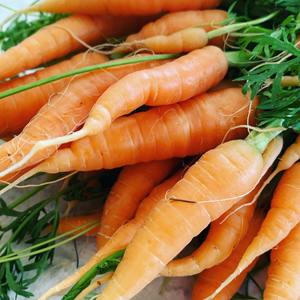
|
Carrot |
3-10
Biennial
Full sun
Moist
Light (sandy), Medium, Heavy (clay)
1.2
Leaves, Root
Apiaceae or Umbelliferae
Möhre, Karotte
https://pfaf.org/User/Plant.aspx?LatinName=Daucus carota sativus
Afghanistan, Albania, Algeria, Austria, Azores, Baleares, Baltic States, Belarus, Belgium, Bulgaria, Canary Is., Cape Verde, Central European Rus, China South-Central, China Southeast, Corse, Cyprus, Czechoslovakia, Denmark, East Aegean Is., East European Russia, Eritrea, Ethiopia, France, Germany, Great Britain, Greece, Hungary, Iran, Iraq, Ireland, Italy, Kazakhstan, Kirgizstan, Kriti, Krym, Lebanon-Syria, Libya, Madeira, Morocco, Nepal, Netherlands, North Caucasus, Northwest European R, Norway, Pakistan, Palestine, Poland, Portugal, Romania, Sardegna, Sicilia, South European Russi, Spain, Sweden, Switzerland, Tadzhikistan, Transcaucasus, Tunisia, Turkey, Turkey-in-Europe, Turkmenistan, Ukraine, Uzbekistan, West Himalaya, Yugoslavia
Alabama, Amsterdam-St.Paul Is, Andaman Is., Angola, Argentina Northeast, Argentina Northwest, Argentina South, Arizona, Arkansas, Bangladesh, Brazil South, British Columbia, California, Cape Provinces, Chile Central, Chile South, China North-Central, Colorado, Connecticut, Costa Rica, Cuba, Delaware, Desventurados Is., District of Columbia, Dominican Republic, Easter Is., Ecuador, El Salvador, Finland, Florida, Georgia, Guatemala, Hainan, Haiti, Iceland, Idaho, Illinois, India, Indiana, Inner Mongolia, Iowa, Jamaica, Japan, Jawa, Kansas, Kentucky, Kermadec Is., Korea, Labrador, Leeward Is., Louisiana, Maine, Manchuria, Manitoba, Marianas, Marshall Is., Maryland, Massachusetts, Mauritius, Mexico Central, Mexico Northeast, Michigan, Minnesota, Mississippi, Missouri, Mongolia, Montana, Myanmar, Nebraska, Nevada, New Brunswick, New Hampshire, New Jersey, New Mexico, New York, New Zealand North, New Zealand South, Newfoundland, Nicobar Is., North Carolina, North Dakota, North European Russi, Northern Provinces, Nova Scotia, Ohio, Oklahoma, Ontario, Oregon, Pennsylvania, Peru, Primorye, Prince Edward I., Puerto Rico, Qinghai, Québec, Rhode I., Rodrigues, Réunion, Saskatchewan, South Carolina, South Dakota, Sri Lanka, Sudan, Tasmania, Tennessee, Texas, Tibet, Trinidad-Tobago, Uruguay, Utah, Vermont, Vietnam, Virginia, Washington, West Siberia, West Virginia, Wisconsin, Wyoming, Xinjiang
0.20
https://powo.science.kew.org/taxon/urn:lsid:ipni.org:names:841063-1
Coffee, Colouring, Condiment
Alcohol, Dye, Essential Oil, Dynamic accumulator, Fragrance
true
|
Carrot (Daucus carota sativus) is a type of root vegetable that is native to Europe and Asia. It belongs to the family Apiaceae, which includes around 300 species of plants. Carrots are a popular crop, known for their sweet, crunchy roots and vibrant orange color. The plant has a tall, slender growth habit and can reach a height of up to 2-3 feet. The leaves are green and feathery, and the flowers are small and white or purple in color. To grow carrots successfully, it is important to choose a location with well-drained, sandy soil and full sun. The plant prefers cool temperatures and should be protected from frost. Carrots can also be grown in containers, and will benefit from regular watering and fertilization. The plant is relatively easy to grow and requires little maintenance, but can be susceptible to pests and diseases, such as carrot fly and root rot. Carrots are a valuable source of vitamins and minerals, and are used in a variety of dishes, including soups, stews, and salads. The roots can be eaten fresh or cooked, and can be stored in the refrigerator for several weeks. In addition to their culinary uses, carrots have a number of medicinal properties, and have been used to treat a variety of ailments, including indigestion, constipation, and respiratory disorders. Carrots are also a valuable food source for many types of wildlife, including birds, insects, and small mammals. The flowers attract bees and other pollinators, and the roots are eaten by animals such as rabbits and deer. |
Show
Edit |
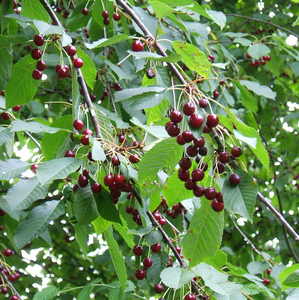
|
Sweet cherry |
3-7
Perennial
Full sun, Partial sun/shade
Moist
Light (sandy), Medium, Heavy (clay)
Deciduous
18.0
Trees
Dye, Gum, Tannin, Lumber, Espalier
true
Fruit, Seed
https://en.wikipedia.org/wiki/Prunus_avium
Fast
Sweet cherry
Rosaceae
Süßkirsche
https://pfaf.org/User/Plant.aspx?LatinName=Prunus avium
183
Afghanistan, Albania, Algeria, Austria, Belarus, Belgium, Bulgaria, Corse, Cyprus, Czechoslovakia, Denmark, France, Germany, Great Britain, Greece, Hungary, Iran, Ireland, Italy, Krym, Libya, Morocco, Netherlands, North Caucasus, Norway, Poland, Portugal, Romania, Sardegna, Sicilia, Spain, Sweden, Switzerland, Transcaucasus, Tunisia, Turkey, Turkey-in-Europe, Ukraine, Yugoslavia
Arizona, Baleares, Baltic States, British Columbia, California, Central European Rus, Connecticut, Delaware, District of Columbia, East European Russia, East Himalaya, Finland, Idaho, Illinois, Indiana, Kazakhstan, Kentucky, Korea, Maine, Maryland, Massachusetts, Michigan, New Brunswick, New Hampshire, New Jersey, New Mexico, New South Wales, New York, New Zealand North, New Zealand South, North Carolina, Nova Scotia, Ohio, Ontario, Oregon, Pakistan, Pennsylvania, Rhode I., South Australia, South Carolina, South European Russi, Tadzhikistan, Tennessee, Turkmenistan, Utah, Victoria, Virginia, Washington, West Himalaya, West Virginia, Wyoming
3
https://powo.science.kew.org/taxon/urn:lsid:ipni.org:names:30093848-2
Gum
|
The sweet cherry, Prunus avium, is a fruit-bearing tree that is native to Europe, western Asia, and northern Africa. It typically grows to a height of 15-30 feet, with a spread of 20-25 feet, and has a rounded crown. The leaves are oblong-shaped, with serrated edges and a glossy dark green color. The flowers are white or pale pink, with five petals, and appear in clusters in the spring before the leaves. The fruit, which is the sweet cherry, is a small, round drupe, with a smooth, dark red or black skin and a juicy, sweet flesh. In terms of growing conditions, the sweet cherry prefers well-drained, fertile soil and full sun exposure. It can be grown in a variety of climates, but may require protection from frost in harsh climates. To cultivate the sweet cherry successfully, a grower may need to prune the tree to maintain its shape, provide adequate water and fertilizer, and protect the tree from pests and diseases. The sweet cherry is edible and can be eaten fresh or used in a variety of culinary dishes. The fruit can be stored in the refrigerator for a few days or preserved by freezing or canning. The sweet cherry is also valued for its medicinal properties, as the fruit and leaves have been used in traditional medicine to treat a variety of ailments. In terms of its value for wildlife, the sweet cherry provides food for a variety of animals, including birds, squirrels, and other small mammals. It also provides shelter and habitat for these animals. |
Show
Edit |
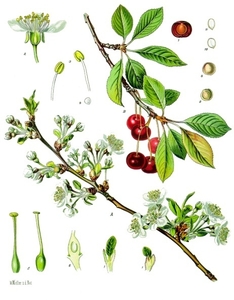
|
Sour cherry |
https://en.wikipedia.org/wiki/Prunus_cerasus
true
Moist
Full sun, Partial sun/shade
3-7
Trees
Light (sandy), Medium, Heavy (clay)
Rosaceae
6.0
Sauerkirsche
Oil, Gum, Tea
Fruit, Seed
Adhesive, Dye, Gum, Hedgerow, oil, Lumber
Perennial
Deciduous
https://pfaf.org/User/Plant.aspx?LatinName=Prunus cerasus
North Caucasus
Afghanistan, Alaska, Argentina South, Austria, Baltic States, Belgium, British Columbia, Bulgaria, California, Central European Rus, Connecticut, Czechoslovakia, Delaware, District of Columbia, East European Russia, East Himalaya, France, Georgia, Germany, Great Britain, Hungary, Idaho, Illinois, Indiana, Iowa, Iran, Ireland, Irkutsk, Italy, Kansas, Kazakhstan, Kentucky, Korea, Madeira, Maine, Maryland, Massachusetts, Michigan, Missouri, Montana, Nebraska, New Brunswick, New Hampshire, New Jersey, New Mexico, New South Wales, New York, New Zealand North, New Zealand South, North Carolina, Nova Scotia, Ohio, Ontario, Oregon, Pakistan, Pennsylvania, Poland, Portugal, Prince Edward I., Québec, Rhode I., Sardegna, Sicilia, South European Russi, Spain, Sweden, Switzerland, Tadzhikistan, Transcaucasus, Turkey, Turkmenistan, Ukraine, Uzbekistan, Vermont, Virginia, Washington, West Himalaya, West Siberia, West Virginia, Xinjiang, Yugoslavia
https://powo.science.kew.org/taxon/urn:lsid:ipni.org:names:729574-1
|
Show
Edit |
|
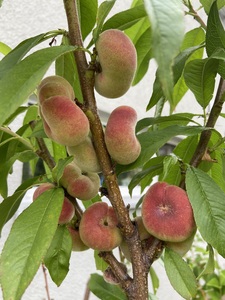
|
Peach |
5-9
Perennial
Full sun
Moist
Light (sandy), Medium, Heavy (clay)
6
Trees
true
Flowers, Fruit, Seed
https://en.wikipedia.org/wiki/Peach
Fast
Flowering peach, ornamental peach, common peach
Rosaceae
Pfirsich, bergpfirsich, tellerpfirsich, saturnpfirsich, weinbergpfirsich
Oil, Gum, Tea
https://pfaf.org/User/Plant.aspx?LatinName=Prunus persica
China North-Central
Afghanistan, Alabama, Argentina Northwest, Arizona, Arkansas, Assam, Baleares, Bulgaria, California, Cape Verde, China South-Central, China Southeast, Colorado, Connecticut, Corse, Cyprus, Delaware, District of Columbia, East European Russia, East Himalaya, Ecuador, El Salvador, Ethiopia, Florida, France, Free State, Georgia, Greece, Hungary, Idaho, Illinois, India, Indiana, Iowa, Iran, Italy, Japan, Kansas, Kazakhstan, Kentucky, Kenya, Kirgizstan, Korea, Kriti, Krym, KwaZulu-Natal, Laos, Libya, Louisiana, Maine, Marianas, Maryland, Massachusetts, Mauritius, Michigan, Mississippi, Missouri, New Jersey, New Mexico, New South Wales, New York, New Zealand North, North Carolina, North Caucasus, Northern Provinces, Nova Scotia, Ohio, Oklahoma, Ontario, Oregon, Pakistan, Pennsylvania, Portugal, Queensland, Rhode I., Rodrigues, Romania, Réunion, Sardegna, South Australia, South Carolina, South European Russi, St.Helena, Switzerland, Tadzhikistan, Tennessee, Texas, Transcaucasus, Turkey, Turkmenistan, Ukraine, Utah, Uzbekistan, Vietnam, Virginia, West Himalaya, West Virginia, Wisconsin
3
https://powo.science.kew.org/taxon/urn:lsid:ipni.org:names:1212858-2
Adhesive, Cleanser, Dye, Gum, oil, Espalier
|
The peach, scientifically known as Prunus persica, is a deciduous tree native to northwest China. It typically grows to be about 10-30 feet tall, with a short trunk and a rounded crown. The leaves are oval-shaped, with serrated edges and a glossy, dark green color. The flowers are pink and white, with five petals each. Peaches are known for their fuzzy, peach-colored skin and juicy, sweet flesh. They can be eaten fresh, canned, or cooked into dishes such as pies and cobblers. The edible parts of the peach include the flesh and the seed, which contains a small kernel that can be ground into flour. Peaches can be stored after harvest by keeping them in a cool, dry place. Peaches prefer well-draining, loamy soil and full sun. They can be grown in a variety of climates, but do best in warm, temperate regions. To cultivate peaches successfully, growers may need to provide support for the trees, prune them regularly, and protect them from pests and diseases. Peaches are generally winter hardy, but can be damaged by frost. In addition to being eaten fresh, peaches have a variety of uses. The flowers can be used in herbal teas, and the leaves can be used to make a yellow dye. The wood of the tree can be used for smoking meat, and the kernels can be used to make oil. Peaches are also a valuable food source for wildlife, attracting birds, squirrels, and other animals. |
Show
Edit |

|
Nectarine |
4-8
Perennial
Full sun
Moist
Light (sandy), Medium, Heavy (clay)
Deciduous
6.0
Trees
Adhesive, Cleanser, Dye, Gum, oil, Espalier
true
Flowers, Fruit, Seed
Rosaceae
Nektarine
Oil, Gum, Tea
https://pfaf.org/User/Plant.aspx?LatinName=Prunus persica nucipersica
Nectarine
Nektarin
3
|
Nectarine (Prunus persica nucipersica) is a plant that is a type of stone fruit. It is native to China and is closely related to the peach. Nectarines are similar in appearance to peaches, but have smooth skin rather than fuzzy skin. They can range in size from small to large and are typically round or oval in shape. Nectarines have green or red leaves and white or pink flowers. The stems of the plant are generally thin and have thorns. Nectarines can grow to be quite large, reaching heights of up to 8 meters. They grow best in warm, sunny climates and well-drained soil. To cultivate nectarines successfully, a grower will need to provide the plant with plenty of sunlight and water. They may also need to prune the plant to maintain its shape and encourage new growth. Nectarines are edible and the fruit can be eaten fresh or cooked. The edible parts of the fruit can be stored in a cool, dry place after harvest. Nectarines have several uses. In addition to being eaten fresh or cooked, they can also be used to make jams, jellies, and other preserves. They can also be dried and used as a snack. In addition to their culinary uses, nectarines have been used medicinally for their high vitamin and mineral content. They are also valued for their ability to attract wildlife, such as birds and bees, to the garden. |
Show
Edit |
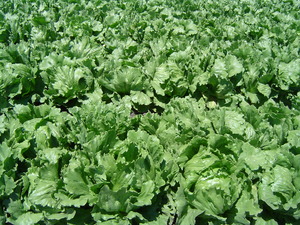
|
Lactuca sativa |
5-9
Annual, Biennial
Full sun, Partial sun/shade
Moist
Light (sandy), Medium
0.9
Herbs
true
Leaves, Seed
https://en.wikipedia.org/wiki/Lettuce
Garden lettuce
Asteraceae or compositae
Blattsalat
Oil
https://pfaf.org/User/Plant.aspx?LatinName=Lactuca sativa
Iraq
Alabama, Antipodean Is., Argentina Northeast, Assam, Austria, Baleares, Baltic States, Bangladesh, Belize, Bolivia, Bulgaria, Burkina, California, Cameroon, Canary Is., Cape Provinces, Cape Verde, Caroline Is., Central European Rus, Chad, China North-Central, Colombia, Connecticut, Corse, Costa Rica, Cuba, Cyprus, Czechoslovakia, Delaware, District of Columbia, Dominican Republic, East European Russia, East Himalaya, Ecuador, Egypt, El Salvador, Fiji, Finland, France, Free State, Germany, Great Britain, Guatemala, Haiti, Hawaii, Honduras, Hungary, Idaho, Illinois, Indiana, Inner Mongolia, Ireland, Italy, Jamaica, Jawa, Kazakhstan, Khabarovsk, Korea, Krym, Lebanon-Syria, Madeira, Maine, Marianas, Marshall Is., Massachusetts, Mauritania, Mauritius, Mexico Southeast, Michigan, Missouri, Myanmar, Nepal, Netherlands, New Guinea, New Hampshire, New Jersey, New Mexico, New York, Nicaragua, Niue, North Carolina, North Caucasus, North Dakota, North European Russi, Northwest European R, Ohio, Oklahoma, Oman, Ontario, Oregon, Pakistan, Panamá, Paraguay, Pennsylvania, Peru, Philippines, Poland, Portugal, Primorye, Puerto Rico, Rhode I., Romania, Réunion, Sardegna, Sicilia, South European Russi, Spain, Sweden, Switzerland, Taiwan, Transcaucasus, Trinidad-Tobago, Tubuai Is., Turkey, Turkey-in-Europe, Ukraine, Uzbekistan, Venezuela, Vermont, Vietnam, Wake I., Washington, West Virginia, Yugoslavia
30cm
https://powo.science.kew.org/taxon/urn:lsid:ipni.org:names:228239-1
Hair, oil, Pest control
|
Lettuce, Lactuca sativa, is a plant native to the Mediterranean region. It has green, elongated leaves that form a loose head. The stem is relatively short and the plant grows to a height of about 8-12 inches. Lettuce is a fast-growing plant, with some varieties able to be harvested in as little as 45 days. Lettuce can be differentiated from similar plants by its elongated leaves and loose head formation. It is also relatively short compared to other leafy green plants like kale and spinach. Lettuce prefers cool temperatures and grows best in full sun or partial shade. It is a hardy plant and can tolerate light frost, but will not survive extreme cold. To cultivate lettuce successfully, growers should ensure that the soil is well-drained and moist, and that the plants are spaced appropriately. Lettuce is edible and the leaves can be eaten raw in salads or cooked. The leaves can also be stored by washing and drying them, and then wrapping them in a damp paper towel before placing them in the refrigerator. Lettuce has a number of uses. It is a popular ingredient in salads and other dishes, and has been used medicinally to treat a variety of ailments, including insomnia and digestive issues. |
Show
Edit |
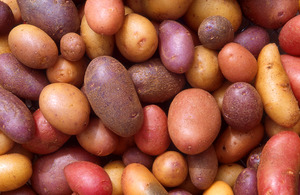
|
Potato |
3-10
Full sun
Moist
Light (sandy), Medium, Heavy (clay)
1.0
0.5
Perennial
12 inches
Seed - direct sow
April
Root
Irish potato, Andigena
Kartoffel
Solanaceae
Argentina Northwest, Argentina South, Bolivia, Chile Central, Chile North, Chile South, Colombia, Ecuador, Peru, Venezuela
Assam, Bangladesh, Belgium, Dominican Republic, East European Russia, East Himalaya, France, Great Britain, Haiti, Hawaii, Illinois, India, Ireland, Laos, Maryland, Minnesota, New York, South European Russi, Tadzhikistan, Uzbekistan, Vietnam, Zaïre
https://en.wikipedia.org/wiki/Potato
https://pfaf.org/User/Plant.aspx?LatinName=Solanum tuberosum
https://powo.science.kew.org/taxon/urn:lsid:ipni.org:names:821337-1
Rutin
Alcohol, Biomass, Cleanser, Cosmetic, Polish, Starch
true
|
Potato (Solanum tuberosum) is a herbaceous perennial plant that is native to the Andean region of South America. It is a member of the nightshade family (Solanaceae) and is closely related to other nightshades such as tomatoes, eggplants, and bell peppers. The potato plant has a bushy growth habit and can grow to heights of 30-150 cm depending on the variety. The leaves are large, heart-shaped, and alternate along the stem. The flowers are white or purple and have five petals. The plant produces small green berries that contain numerous seeds, but most varieties of potatoes are propagated vegetatively from tubers rather than from seeds. The edible part of the potato plant is the tuber, which is an underground stem that is modified for food storage. Potatoes come in a wide range of shapes, sizes, and colors including white, yellow, red, and purple. The size and shape of the tuber depends on the variety, with some varieties producing small, round tubers and others producing large, elongated tubers. Potatoes grow best in well-draining, fertile soils in a sunny location with a pH of 4.5-6.0. They require regular watering and should be planted in a location with good air circulation to prevent fungal diseases. Potatoes are typically planted from tubers that have been treated with a fungicide to prevent disease and are spaced 25-30 cm apart in rows that are 75-90 cm apart. The tubers will begin to form in the soil around 6-8 weeks after planting and can be harvested when they reach the desired size. Potatoes are a versatile and nutritious food source that is rich in vitamins, minerals, and fiber. The tubers are eaten cooked, baked, fried, or mashed, and the leaves and flowers of the plant can also be eaten. Potatoes can be stored in a cool, dry, and dark place for several months. Potatoes have a number of uses beyond their value as a food source. The tubers can be used as seed potatoes for planting, and the leaves and stems can be used as a natural insecticide or as mulch in the garden. In some parts of the world, potatoes are also used for their medicinal properties. Potatoes are a valuable food source for a variety of wildlife, including deer, rabbits, and squirrels. The flowers of the potato plant are also a source of nectar for bees and other pollinators. |
Show
Edit |
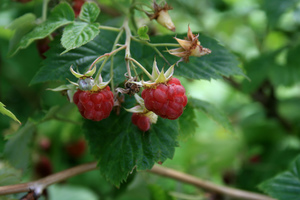
|
Red raspberry |
3-8
Perennial
Full sun, Partial sun/shade
Moist
Light (sandy), Medium, Heavy (clay)
Deciduous
2.0
Shrubs
Cosmetic, Dye, textiles
true
Fruit, Root, Shoots, Stem
https://en.wikipedia.org/wiki/Rubus_idaeus
Medium
American red raspberry, Grayleaf red raspberry
Rosaceae
Himbeere
https://pfaf.org/User/Plant.aspx?LatinName=Rubus idaeus
Framboos
Hindbær
Alaska, Albania, Altay, Amur, Arizona, Austria, Baltic States, Belarus, Belgium, British Columbia, Bulgaria, Buryatiya, California, Central European Rus, China North-Central, China South-Central, Chita, Colorado, Connecticut, Corse, Czechoslovakia, Delaware, Denmark, District of Columbia, East European Russia, Finland, France, Germany, Great Britain, Greece, Hungary, Idaho, Illinois, Indiana, Iowa, Ireland, Irkutsk, Italy, Japan, Kazakhstan, Khabarovsk, Kirgizstan, Korea, Krasnoyarsk, Krym, Labrador, Magadan, Maine, Manchuria, Manitoba, Maryland, Massachusetts, Mexico Gulf, Mexico Northeast, Mexico Northwest, Michigan, Minnesota, Missouri, Mongolia, Montana, Nebraska, Netherlands, Nevada, New Brunswick, New Hampshire, New Jersey, New Mexico, New York, Newfoundland, North Carolina, North Caucasus, North Dakota, North European Russi, Northwest European R, Northwest Territorie, Norway, Nova Scotia, Nunavut, Ohio, Oklahoma, Ontario, Oregon, Pennsylvania, Poland, Primorye, Prince Edward I., Qinghai, Québec, Rhode I., Romania, Sakhalin, Saskatchewan, Sicilia, South Dakota, South European Russi, Spain, Sweden, Switzerland, Tennessee, Transcaucasus, Turkey, Turkey-in-Europe, Turkmenistan, Tuva, Ukraine, Utah, Vermont, Virginia, Washington, West Siberia, West Virginia, Wisconsin, Wyoming, Xinjiang, Yakutskiya, Yugoslavia, Yukon
Arkansas, Falkland Is., Iceland, Mexico Central, Mexico Southwest, Mississippi, New Zealand North, New Zealand South, Tadzhikistan, Uzbekistan, Victoria
1.5
https://powo.science.kew.org/taxon/urn:lsid:ipni.org:names:298089-2
Coffee, Tea
|
Raspberry (Rubus idaeus) is a plant native to Europe, Asia, and North America. It is a perennial plant that grows upright with canes that can reach up to 5 feet in height. The leaves are green and compound, with 3-5 leaflets on each stem. The flowers are white or pink and have five petals. The fruit of the raspberry plant is a red, edible drupe that is about the size of a small marble. Raspberry plants prefer well-drained soil and full sun, but they can also tolerate partial shade. To cultivate raspberries successfully, a grower may need to provide support for the canes, as well as prune them regularly to promote new growth. Raspberries are typically propagated through root cuttings or by dividing the root system. Raspberries are edible and the fruit can be eaten fresh or used in a variety of dishes. The fruit can also be frozen or canned for later use. In addition to their use as a food, raspberries have been used medicinally for their astringent and anti-inflammatory properties. The leaves of the raspberry plant can also be brewed into a tea. Raspberry plants are valued for their fruit, but they also provide habitat and food for a variety of wildlife, including birds and small mammals. The plants can be used as a natural form of pest control, as they attract beneficial insects that prey on pest insects. |
Show
Edit |
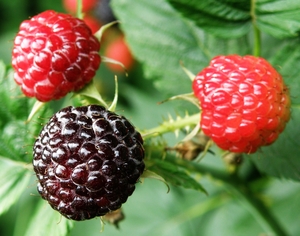
|
Black raspberry |
https://en.wikipedia.org/wiki/Rubus_occidentalis
true
Moist
Full sun, Partial sun/shade
3-7
Shrubs
Light (sandy), Medium, Heavy (clay)
Rosaceae
3.0
Schwarze himbeere
Tea
Fruit, Shoots, Stem
Dye
Perennial
Deciduous
https://pfaf.org/User/Plant.aspx?LatinName=Rubus occidentalis
Alabama, Arkansas, Connecticut, Delaware, District of Columbia, Georgia, Illinois, Indiana, Iowa, Kansas, Kentucky, Maine, Maryland, Massachusetts, Michigan, Minnesota, Mississippi, Missouri, Nebraska, New Brunswick, New Hampshire, New Jersey, New York, North Carolina, North Dakota, Ohio, Oklahoma, Ontario, Pennsylvania, Québec, Rhode I., South Carolina, South Dakota, Tennessee, Vermont, Virginia, West Virginia, Wisconsin
Central European Rus, Colorado, Czechoslovakia, Poland
https://powo.science.kew.org/taxon/urn:lsid:ipni.org:names:223350-2
|
Show
Edit |
|

|
Rose |
2
Perennial
Full sun, Partial sun/shade
Deciduous
Shrubs
Animal feed, Attracts insects, Hedgerow, Wind breaker, Wildlife habitat
True
Fruit
Rosaceae
Zambia
https://powo.science.kew.org/taxon/urn:lsid:ipni.org:names:77120313-1
1
|
Show
Edit |
|
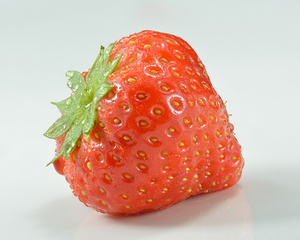
|
Strawberry |
4-8
Perennial
Full sun, Partial sun/shade
Moist
Light (sandy), Medium, Heavy (clay)
0.3
Herbs
Ground cover
True
Fruit, Leaves
https://en.wikipedia.org/wiki/Strawberry
Rosaceae
Erdbeere
https://pfaf.org/User/Plant.aspx?LatinName=Fragaria x ananassa
Aardbei
Jordbær
British Columbia, California, Oregon, Washington
Albania, Baltic States, Belarus, Central European Rus, Denmark, East European Russia, El Salvador, Finland, France, Germany, Great Britain, Guatemala, Honduras, Illinois, Ireland, Italy, Japan, Korea, Netherlands, New York, North European Russi, Northwest European R, Norway, Pitcairn Is., South European Russi, Sweden, Switzerland, Tadzhikistan, Turkey, Turkmenistan, Vermont
0.3
https://powo.science.kew.org/taxon/urn:lsid:ipni.org:names:30117681-2
|
Strawberry (Fragaria × ananassa) is a popular fruit-bearing plant that is native to parts of the Americas, Europe, and Asia. It is a member of the Rosaceae family and is closely related to other fruit-bearing plants such as raspberries and blackberries. The plant has a low-growing, spreading habit, with leaves that are typically green and glossy, and white flowers that give way to red, juicy berries. The fruits are edible and are often eaten fresh, used in jams and jellies, or baked in desserts. Strawberry plants prefer well-draining, moist soil and plenty of sunlight. They can be grown in a variety of climates, but they tend to thrive in temperate regions with cool summers and mild winters. To cultivate the plants successfully, a grower may need to provide adequate irrigation, fertilizer, and pest control. One of the distinctive features of strawberry plants is their runners, which are long, slender stems that grow horizontally along the ground. These runners can be used to propagate new plants, which can be grown in rows or beds to form a dense, ground-covering mat. In addition to their value as a food source, strawberry plants are also prized for their attractiveness to pollinators and other beneficial insects. They are often used in home gardens and on small farms as a way to attract bees, butterflies, and other insects that help to pollinate other plants. Overall, strawberries are a versatile and valuable plant that is prized by gardeners and farmers alike for their delicious fruit and their ability to attract wildlife. |
Show
Edit |
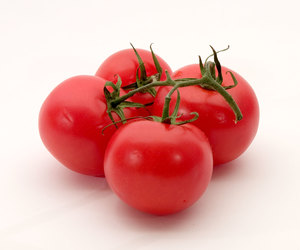
|
Tomato |
10-12
Annual, Perennial
Full sun
Moist
Light (sandy), Medium, Heavy (clay)
2.0
True
Fruit, Seed
https://en.wikipedia.org/wiki/Tomato
Fast
Garden tomato, Dumádu, Garden tomato, Love apple, Lycopersicum esculentum, Tomate, Tomato, Tomato extract containing lycopene, Tomato|thakkali, Tumatis, Lycopersicon esculentum
Solanaceae
Tomate
Oil
https://pfaf.org/User/Plant.aspx?LatinName=Solanum lycopersicum, https://pfaf.org/User/Plant.aspx?LatinName=Lycopersicon esculentum
Start seeds indoors 5-6 weeks before last frost
In containers or in rows in beds around last frost date
6.2-6.8
70-80°f
Peru
Alabama, Alaska, Andaman Is., Angola, Arizona, Arkansas, Assam, Austria, Azores, Bahamas, Bangladesh, Belarus, Benin, Bolivia, British Columbia, Bulgaria, Burkina, California, Cambodia, Cameroon, Canary Is., Cape Verde, Caroline Is., Central African Repu, Chagos Archipelago, Chatham Is., Christmas I., Colombia, Comoros, Connecticut, Cook Is., Costa Rica, Cuba, Cyprus, Czechoslovakia, Delaware, Dominican Republic, East Aegean Is., East European Russia, East Himalaya, Ecuador, Fiji, Florida, Galápagos, Georgia, Gilbert Is., Gulf of Guinea Is., Haiti, Hawaii, Illinois, India, Indiana, Iowa, Ivory Coast, Jawa, Kansas, Kazakhstan, Kentucky, Korea, Laccadive Is., Laos, Leeward Is., Line Is., Louisiana, Madagascar, Madeira, Maine, Malawi, Mali, Marianas, Marquesas, Marshall Is., Maryland, Massachusetts, Mauritania, Mauritius, Michigan, Mississippi, Missouri, Montana, Mozambique, Myanmar, Namibia, Nansei-shoto, Nauru, Nebraska, Nepal, Nevada, New Brunswick, New Caledonia, New Hampshire, New York, New Zealand North, Nicaragua, Nicobar Is., Niue, North Carolina, North Dakota, Nova Scotia, Ogasawara-shoto, Ohio, Ontario, Oregon, Pakistan, Panamá, Pennsylvania, Philippines, Pitcairn Is., Puerto Rico, Québec, Rhode I., Réunion, Saskatchewan, Selvagens, Society Is., South Carolina, South European Russi, Tadzhikistan, Taiwan, Tennessee, Texas, Trinidad-Tobago, Tuamotu, Tubuai Is., Turkey, Turkmenistan, Tuvalu, Utah, Uzbekistan, Venezuela, Vermont, Vietnam, Virginia, Wake I., Wisconsin, Zambia, Zaïre, Zimbabwe
1.00
https://powo.science.kew.org/taxon/urn:lsid:ipni.org:names:316947-2
|
The tomato is a flowering plant native to South America. It is a member of the nightshade family and closely related to the potato. The tomato plant typically grows to a height of 1-3 meters and has a weak, hairy stem. The leaves are arranged alternately on the stem and are typically dark green in color. The plant produces small yellow or white flowers, which develop into the fruit we know as tomatoes. The fruit itself is typically red, but can also be yellow, orange, green, or purple. Indeterminate tomato plants are perennials in their native habitat, but are cultivated as annuals. Determinate, or bush, plants are annuals that stop growing at a certain height and produce a crop all at once. Tomatoes prefer warm, sunny growing conditions and well-drained, humus-rich soil. They can be grown in a variety of soil types, but perform best in soil with a pH between 6 and 6.8. In order to cultivate tomatoes successfully, growers may need to provide support for the plant (such as a stake or cage) to prevent the fruit from weighing down the stem, and may also need to water and fertilize the plant regularly. Tomatoes are generally considered to be frost-sensitive, so in areas with cold winters they may need to be grown in a greenhouse or indoors. There are a great number of cultivars. The edible parts of the tomato plant are the fruit and the leaves. The fruit can be eaten raw or cooked, and is commonly used in a variety of dishes, such as salads, sandwiches, and pasta. The leaves, although not commonly eaten, are also edible and have a slightly bitter taste. After harvest, tomatoes can be stored at room temperature, in a cool place, or in the refrigerator. |
Show
Edit |

|
Cauliflower |
3-10
Full sun, Partial sun/shade
Moist
Light (sandy), Medium, Heavy (clay)
0.8
Annual, Biennial
3-7 years
Companion, antifungal, Dynamic accumulator
true
Flowers, Leaves
Blumenkohl
Brassicaceae or cruciferae
https://pfaf.org/User/Plant.aspx?LatinName=Brassica oleracea botrytis
|
Annual plant reproduced by seed. |
Show
Edit |
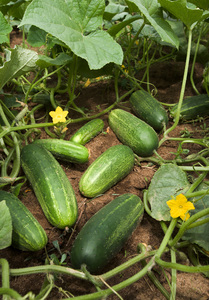
|
Cucumis sativus |
9-11
Annual
Full sun
Moist
Light (sandy), Medium, Heavy (clay)
2
Vines
Fruit, Leaves, Seed
Seed - direct sow, Seed - transplant
1 week after last frost
https://en.wikipedia.org/wiki/Cucumber
Cucurbitaceae
Gurke
50-65
23cm
6.0-6.8
15-30°C (60-85°F)
https://pfaf.org/User/Plant.aspx?LatinName=Cucumis sativus
True
Fruit
Assam, Bangladesh, China South-Central, China Southeast, East Himalaya, Myanmar, Nepal, Thailand, West Himalaya
Alabama, Albania, Andaman Is., Arizona, Arkansas, Austria, Bahamas, Bolivia, Caroline Is., Cayman Is., Colombia, Costa Rica, Cuba, Czechoslovakia, Denmark, Dominican Republic, Ecuador, Florida, Georgia, Gulf of Guinea Is., Haiti, Illinois, India, Jamaica, Kansas, Kazakhstan, Kentucky, Korea, Laos, Leeward Is., Louisiana, Marianas, Marshall Is., Massachusetts, Michigan, Mississippi, Missouri, New Caledonia, New York, Nicaragua, Nicobar Is., North Carolina, North Caucasus, Ohio, Oman, Ontario, Pakistan, Pennsylvania, Pitcairn Is., Puerto Rico, South Carolina, Sri Lanka, Sweden, Tadzhikistan, Trinidad-Tobago, Turkmenistan, Utah, Uzbekistan, Venezuela, Vietnam, Virginia, Windward Is., Zaïre
2-3 weeks before last frost
1 week after last frost
0.9
https://powo.science.kew.org/taxon/urn:lsid:ipni.org:names:292296-1
Oil
Cosmetic, oil
true
|
Cucumber, scientific name Cucumis sativus, is a member of the gourd family. It is native to India and other parts of Asia. Cucumber is a trailing or climbing plant that grows to a height of 5-10 feet. The leaves are dark green and glossy, and the plant produces yellow flowers. The fruit of the cucumber plant is a long, green, edible vegetable with a thin skin. Cucumbers are typically about 6-9 inches long and 2-3 inches in diameter. In terms of growth and cultivation, cucumber plants prefer warm, sunny conditions and well-draining soil. They should be watered regularly, especially during dry periods. Cucumber plants are not winter hardy and should be grown in the summer months in most climates. To cultivate cucumbers successfully, it is important to provide them with adequate space to grow and to support the plants with trellises or other means to keep the fruits off the ground. The plant will develop male and female flowers. You can recognize the female by having a tiny cucumber underneath. Sometimes the plant develops a lot of male flowers first, so be patient. If you don’t see any bees pollinating. Take a male and put it on all the female flowers. Cucumber fruits are edible and can be eaten raw, pickled, or cooked. The skin and seeds of the cucumber are edible, but some people choose to remove the seeds before eating the fruit. Cucumber fruits can be stored in the refrigerator for a few days after harvest. Cucumbers have several uses. In addition to being eaten as a vegetable, they can also be used in a variety of dishes and salads. Cucumber slices are often used as a garnish or as a refreshing addition to beverages. Cucumbers are also commonly used in natural skin care products and are believed to have anti-inflammatory and soothing properties. #### Propagation Direct sow when soil is warm enough in early summer. Sow seeds individually indoors 3-4 weeks before planting outside into warm soil. Use bottom heat if possible. Transplant when plants develop third leaf. #### Medicinal Fruit is depurative, diuretic, emollient, purgative and resolvent #### Links [Cucumber @ West Coast Seeds](https://www.westcoastseeds.com/products/patio-snacker) |
Show
Edit |
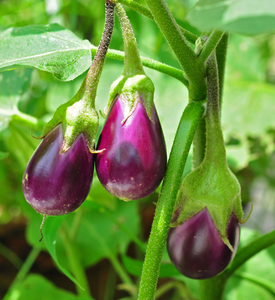
|
Solanum melongena |
8-11
Full sun
Moist
Light (sandy), Medium, Heavy (clay)
1.0
1
Perennial
true
Fruit, Leaves
Eggplant
Aubergine
Solanaceae
China South-Central, Laos, Malaya, Myanmar, Thailand, Vietnam
Assam, Bangladesh, Cambodia, East Himalaya, India, Kazakhstan, Laccadive Is., Sri Lanka, Tadzhikistan, Turkmenistan, Uzbekistan, Zaïre
https://en.wikipedia.org/wiki/Eggplant
https://pfaf.org/User/Plant.aspx?LatinName=Solanum melongena
https://powo.science.kew.org/taxon/urn:lsid:ipni.org:names:820053-1
|
The eggplant, also known as Solanum melongena, is a plant that is native to India and Southeast Asia. It is typically an annual plant. It is a member of the nightshade family and is closely related to other vegetables such as tomatoes and peppers. Eggplants are typically recognized by their deep purple, spongy fruit, but they can come in a variety of sizes and colors (white, green, black, purple striped). The fruit is elongated and cylindrical in shape, and can grow to be anywhere from 6-12 inches in length. The leaves of the eggplant are broad and dark green in color, and the plant itself can grow to be quite tall, reaching heights of 3-4 feet. Eggplants prefer warm, sunny growing conditions and can be grown in a wide range of soils as long as they are well-draining. They are typically grown as a summer crop, and will begin to produce fruit around 2-3 months after planting. To cultivate eggplants successfully, a grower will need to provide the plants with adequate water and nutrients, and may need to use stakes or other supports to help the plant grow upright. Eggplants are not winter hardy and will not survive freezing temperatures. The fruit of the eggplant is edible and is often used in a variety of dishes, particularly in Mediterranean and Asian cuisines. It can be sliced and fried, grilled, or used in stews and soups. The skin of the fruit is typically removed before eating, and the flesh can be stored in the refrigerator for a few days after harvesting. In addition to being used as a food source, eggplants have also been used for medicinal purposes in some cultures. The plant is believed to have anti-inflammatory properties, and has been used to treat a variety of ailments including headache and rheumatism. It is also sometimes used as a natural insect repellent. |
Show
Edit |
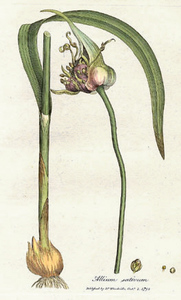
|
Garlic |
3-10
Perennial
Full sun
Dry, Moist
Light (sandy), Medium
0.6
Herbs
Flowers, Leaves, Root, Seed
Seed - direct sow
https://en.wikipedia.org/wiki/Garlic
Cultivated garlic
Alliaceae
Knoblauch
20cm
https://pfaf.org/User/Plant.aspx?LatinName=Allium sativum
6.5-7.0
Sting and itch relief from insect bites
Fibrous
Shallow
100-150
Allium
Iran, Kazakhstan, Kirgizstan, Tadzhikistan, Turkmenistan, Uzbekistan
Albania, Algeria, Amur, Austria, Baleares, Baltic States, Bangladesh, Belarus, Bulgaria, Cambodia, Canary Is., Central European Rus, China North-Central, China South-Central, China Southeast, Corse, Cuba, Czechoslovakia, Dominican Republic, East European Russia, Egypt, Ethiopia, France, Galápagos, Germany, Greece, Haiti, Hungary, Illinois, India, Iraq, Italy, Jamaica, Kentucky, Korea, Leeward Is., Libya, Mexico Central, Mexico Northwest, Mexico Southeast, Mexico Southwest, Morocco, New York, North European Russi, Northwest European R, Pakistan, Poland, Primorye, Puerto Rico, Romania, Sardegna, Seychelles, Sicilia, South European Russi, Spain, Switzerland, Tennessee, Thailand, Trinidad-Tobago, Tunisia, Turkey, Ukraine, Vermont, Wisconsin, Yugoslavia
Late autumn, Early spring
https://powo.science.kew.org/taxon/urn:lsid:ipni.org:names:528796-1
Adhesive, antifungal, Dynamic accumulator
true
|
Garlic (Allium sativum) is a bulbous perennial plant in the family Amaryllidaceae. It is native to central Asia and northeastern Iran, and has long been a staple in cuisines around the world. The plant has a distinctive appearance, with narrow, long leaves and a tall, hollow stem. The leaves are a pale green color and are attached to the stem in a spiral arrangement. The flowers are small and white, and are clustered in a spherical head at the top of the stem. Garlic plants can grow to a height of 30-150 cm (12-59 in), depending on the variety. They are relatively fast-growing plants, with the bulbs maturing in about seven months. Mulch for proper overwintering when planted in autumn. Garlic can be differentiated from other plants in the Allium genus by its distinctive flavor and aroma. It is also often distinguished by its long, narrow leaves and tall, hollow stem. Garlic prefers well-drained soil and full sun, and is typically grown from bulbs. To cultivate garlic successfully, growers should plant the bulbs in the fall, about 6-8 weeks before the first frost. The bulbs should be spaced about 10-15 cm (4-6 in) apart, with the pointed end facing up. After planting, the bulbs should be watered regularly and mulched to protect them from cold temperatures. Garlic is edible, with the bulbs and leaves being the most commonly eaten parts of the plant. The bulbs can be used fresh or cooked, and are often used as a seasoning in a wide variety of dishes. The leaves can be used fresh or cooked, and have a milder flavor than the bulbs. To harvest dig and do not pull out the bulbs. Let them dry in an airy, shady and dry spot e.g. by hanging them up. Once wrappers are dry, it can be stored at a dry place for several months. In addition to its culinary uses, garlic has a number of other uses. It is commonly used medicinally, as it has been shown to have antimicrobial and anti-inflammatory properties. It is also sometimes used as a natural insect repellent. In the garden, it can be used as a natural fertilizer, as it is believed to improve the soil and help deter pests. Garlic has value for wildlife, as it is attractive to a wide variety of pollinators, including bees, butterflies, and hummingbirds. It is also a food source for animals such as rabbits and deer. |
Show
Edit |
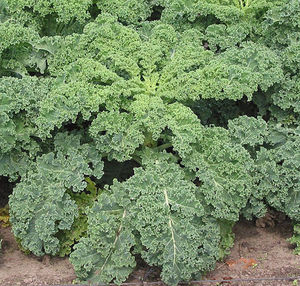
|
Kale |
5-10
Full sun, Partial sun/shade
Moist
Light (sandy), Medium, Heavy (clay)
6.0-6.8
Deciduous
0.9
Biennial, Perennial
Herbs
Fast
45cm
Seed - direct sow, Seed - transplant
At last frost date
4-6 weeks before last frost
7-10 days
3 to 7 years
Dynamic accumulator
true
Shoots
Brassicaceae, Cruciferae
True
https://en.wikipedia.org/wiki/Kale
https://pfaf.org/User/Plant.aspx?LatinName=Brassica oleracea acephala
Shallow
0.5 cm
60
|
Kale (/keɪl/) is a hardy, leafy green vegetable that is a member of the Brassica oleracea species. It is native to the eastern Mediterranean and Asia Minor, and has been cultivated for food for over 2000 years. Kale plants typically have green or purple leaves that are deeply lobed and can grow up to 2 feet in length. The leaves are attached to a central stem and don't make a head, and the plant produces small, yellow flowers. Kales are considered to be closer to wild cabbage than most of the many domesticated forms of Brassica oleracea. In terms of growing conditions, kale prefers cool weather and does well in full sun to partial shade. It can be grown year-round in mild climates, but in colder climates it is best grown in the fall and early spring. To cultivate kale successfully, it is important to provide the plants with plenty of moisture and to regularly fertilize them. Kale is also a good companion plant for other vegetables, as it can help to deter pests and improve the health of the soil. In terms of edibility, kale is highly nutritious and can be eaten raw or cooked. The leaves and stems are both edible, and the plant can be stored in the refrigerator for several days after harvest. Kale can be used in a variety of dishes, including soups, salads, and smoothies. It can also be cooked and served as a side dish, or used as a garnish. In addition to its culinary uses, kale has a number of other uses. It is often used as a cover crop, as it can help to improve the fertility of the soil. Kale leaves can also be used as a mulch, as they break down readily and release nutrients into the soil. Additionally, kale plants can be used for wind protection, as their large leaves and sturdy stems can provide a barrier to wind. ### Links [Kale @ West Coast Seeds](https://www.westcoastseeds.com/blogs/how-to-grow/grow-kale-collards) |
Show
Edit |
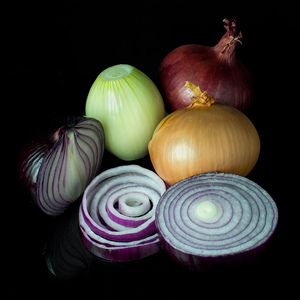
|
Allium cepa |
3-9
Annual
Full sun
Moist
Light (sandy), Medium
0.6
Herbs
Flowers, Leaves, Root, Seed
Seed - direct sow, Seed - transplant
https://en.wikipedia.org/wiki/Onion
Garden onion
Alliaceae
Zwiebel
https://pfaf.org/User/Plant.aspx?LatinName=Allium cepa
50°f, 10°c
Seed indoors 6 weeks before transplanting in the garden
2-6 inches
6.0-7.0
Allium
Turkmenistan
Algeria, Argentina Northeast, Arkansas, Baltic States, Bangladesh, Belarus, Bulgaria, California, Cambodia, Canary Is., Central European Rus, China North-Central, China South-Central, China Southeast, Colombia, Cuba, Czechoslovakia, Dominican Republic, East Aegean Is., East European Russia, East Himalaya, Ecuador, Egypt, Ethiopia, Fiji, France, Galápagos, Guinea-Bissau, Haiti, Illinois, India, Iraq, Italy, Jamaica, Kansas, Kentucky, Kirgizstan, Korea, Krym, Libya, Louisiana, Madeira, Manchuria, Mauritania, Mexico Central, Mexico Gulf, Mexico Northeast, Mexico Southeast, Mexico Southwest, Minnesota, Montana, Morocco, New York, Niue, North European Russi, Northwest European R, Oregon, Pakistan, Puerto Rico, Seychelles, South European Russi, Spain, Tadzhikistan, Texas, Thailand, Tibet, Tonga, Trinidad-Tobago, Ukraine, Uzbekistan, Vermont, Washington, West Himalaya, West Siberia, Wisconsin, Xinjiang, Yugoslavia
Spring or fall
0.3
https://powo.science.kew.org/taxon/urn:lsid:ipni.org:names:527795-1
Cosmetic, Dye, Hair, Polish, Rust
true
|
Onion (Allium cepa) is a plant species in the family Amaryllidaceae. It is native to central Asia and is commonly grown as a vegetable in many parts of the world. Onions are biennial plants, meaning they typically have a two-year life cycle. In the first year, the onion forms a small, rounded bulb with thin, papery skin. In the second year, the onion will produce a tall stem with hollow, elongated leaves and a small, spherical flower head. Onions are typically grown for their bulbs, which are used as a food ingredient in many dishes. The bulbs can vary in size and shape, depending on the variety, but are generally spherical or oblong in shape and range in size from about 2-4 inches in diameter. Onions are commonly differentiated by their color, which can range from white to yellow to red. Onions prefer well-drained soil that is rich in organic matter. They should be planted in a sunny location and will benefit from regular watering, especially during dry periods. Onion bulbs can be harvested when they reach the desired size, typically after about 100-150 days of growth. To store onions, they should be dried and cured in a cool, dry place for about two weeks before being placed in a mesh bag or other breathable container. Onions are edible and are commonly used as a food ingredient in many dishes. The bulbs are the most commonly used part of the plant, but the leaves and stems can also be used in cooking. Onions have a pungent, spicy flavor and are often used to add flavor to soups, stews, and other dishes. Onions can be stored for several months if properly dried and cured. In addition to their use as a food ingredient, onions have also been used for their medicinal properties. They have been used to treat a variety of ailments, including coughs, colds, and respiratory infections. Onions are also sometimes used as a natural fertilizer, due to the high levels of sulfur and other nutrients they contain. Onions are not known to provide significant value to wildlife. They are not a preferred food source for most animals and do not provide any significant habitat value. However, some insects, such as the onion maggot, can be pests of onion crops. |
Show
Edit |
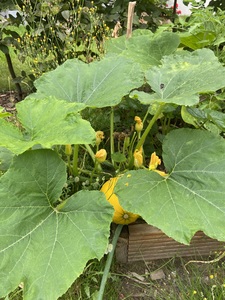
|
Squash |
2-11
Full sun, Partial sun/shade
Moist
Light (sandy), Medium, Heavy (clay)
5.5-5.9
0.6
8
Annual
Vines
Fast
Seed - transplant
after last frost
2 weeks
Flowers, Fruit, Leaves, Seed
Oil
Crookneck squash
Kürbis
Cucurbitaceae
https://en.wikipedia.org/wiki/Cucurbita_moschata
https://pfaf.org/User/Plant.aspx?LatinName=Cucurbita moschata
sow seeds in pots in a greenhouse
boiled root is galactogogue, anthelmintic
oil
true
|
Squash, also known as Cucurbita moschata, is a plant that is native to the Americas. It is commonly used in gardens and farms for its edible fruits and leaves. Squash plants can grow to be quite large, with some varieties reaching heights of up to 10 feet. They tend to grow quickly, with a mature plant producing fruit within a few months of planting. In terms of growing conditions, squash plants prefer full sun and well-draining soil. They also need plenty of water, especially during the hot summer months. To cultivate squash successfully, a grower may need to provide adequate space for the plant to spread out, as well as support for the vines and fruit. Squash needs lots nutrition and therefore needs good soil. It can also be grown on compost The edible parts of squash plants include the fruit and leaves. The fruit can be stored after harvest by keeping it in a cool, dry place. The leaves can also be eaten, either cooked or raw, and can be stored in the same way as the fruit. The fruit can be used in a variety of dishes, including soups, stews, and baked goods. The leaves can be used as a substitute for spinach in many recipes. In addition to its culinary uses, squash has a number of medicinal uses. The leaves have been used to treat a variety of ailments, including infections and inflammation. Squash plants can also be used for fertility, as the large leaves provide shade and moisture for the soil. They can also be used as mulch, wind protection, and ground cover. |
Show
Edit |
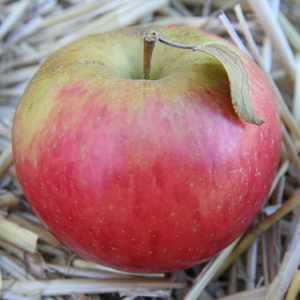
|
Apple |
3-8
Full sun, Partial sun/shade
Moist
Light (sandy), Medium, Heavy (clay)
Deciduous
10.0
9
Perennial
Trees
Animal feed, Attracts insects, Hedgerow
True
Fruit
Oil
Appel
Æble
Rosaceae
Malus
Afghanistan, Kazakhstan, Kirgizstan, Pakistan, Tadzhikistan, Uzbekistan, Xinjiang
Alabama, Alaska, Albania, Argentina Northeast, Argentina South, Arkansas, Azores, Baleares, Baltic States, Belarus, Belgium, British Columbia, Bulgaria, California, Central European Rus, Colorado, Connecticut, Cyprus, Czechoslovakia, Delaware, Denmark, District of Columbia, East European Russia, East Himalaya, Ecuador, Falkland Is., Finland, France, Georgia, Germany, Great Britain, Greece, Hungary, Illinois, Indiana, Iowa, Iraq, Ireland, Italy, Kansas, Kentucky, Korea, Krym, Louisiana, Madeira, Maine, Manitoba, Maryland, Massachusetts, Michigan, Minnesota, Mississippi, Missouri, Montana, Nebraska, Nepal, Netherlands, Nevada, New Brunswick, New Hampshire, New Jersey, New Mexico, New South Wales, New York, Newfoundland, North Carolina, North Caucasus, North Dakota, Norway, Nova Scotia, Ohio, Ontario, Oregon, Pennsylvania, Poland, Prince Edward I., Québec, Rhode I., Romania, South Carolina, South European Russi, Spain, Sweden, Tasmania, Tennessee, Turkmenistan, Ukraine, Utah, Vermont, Victoria, Virginia, West Virginia, Wisconsin, Wyoming, Yugoslavia
https://en.wikipedia.org/wiki/Apple
https://pfaf.org/user/plant.aspx?LatinName=Malus+domestica
https://powo.science.kew.org/taxon/urn:lsid:ipni.org:names:726282-1
Apfel
|
An apple is an edible fruit produced by an apple tree (Malus domestica). Apple trees are cultivated worldwide and are the most widely grown species in the genus Malus. The tree originated in Central Asia, where its wild ancestor, Malus sieversii, is still found today. Apples have been grown for thousands of years in Asia and Europe and were brought to North America by European colonists. Apples have religious and mythological significance in many cultures, including Norse, Greek, and European Christian tradition. Apples grown from seed tend to be very different from those of their parents, and the resultant fruit frequently lacks desired characteristics. Generally, apple cultivars are propagated by clonal grafting onto rootstocks. Apple trees grown without rootstocks tend to be larger and much slower to fruit after planting. Rootstocks are used to control the speed of growth and the size of the resulting tree, allowing for easier harvesting. There are more than 7,500 known cultivars of apples. Different cultivars are bred for various tastes and uses, including cooking, eating raw, and cider production. Trees and fruit are prone to a number of fungal, bacterial, and pest problems, which can be controlled by a number of organic and non-organic means. In 2010, the fruit's genome was sequenced as part of research on disease control and selective breeding in apple production. Worldwide production of apples in 2018 was 86 million tonnes, with China accounting for nearly half of the total. From [Wikipedia](https://en.wikipedia.org/wiki/Apple) |
Show
Edit |
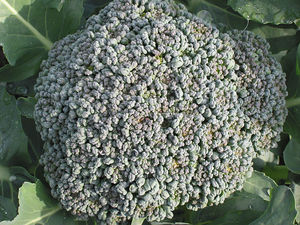
|
Broccoli |
2-11
Full sun, Partial sun/shade
Moist
Light (sandy), Medium, Heavy (clay)
6.0-7.0
0.9
Annual, Biennial
45cm
6-8 weeks before last frost
7-10 days
4°C (40°F)
50-100
3 to 7 years
Companion
true
Flowers, Leaves, Shoots
Brokkoli
Brassicaceae or Cruciferae
https://pfaf.org/User/Plant.aspx?LatinName=Brassica oleracea italica
|
Broccoli is a plant that is native to the Mediterranean region. It is part of the Brassica oleracea family, which also includes other vegetables such as cauliflower and cabbage. Broccoli plants have green, flowering heads that are similar in appearance to cauliflower. The stems are typically thick and can grow to be quite large, depending on the variety of broccoli. The leaves of the plant are typically dark green and are arranged in a spiral pattern along the stem. When it comes to growing conditions, broccoli prefers cool weather and well-draining soil. It is a relatively fast-growing plant, with the flowering heads typically forming in the first year. To cultivate broccoli successfully, a grower will need to make sure the plant gets enough water and sunlight, and provide it with the necessary nutrients through fertilization. In terms of winter hardiness, broccoli is not very frost-tolerant, so it is typically grown as a cool-season crop in areas with mild winters. In terms of edibility, broccoli is a very nutritious vegetable that is packed with vitamins and minerals. The flowering heads and the stems are both edible, and can be cooked in a variety of ways. After harvest, broccoli can be stored in the refrigerator for several days, or frozen for longer-term storage. ### Propagation - Direct sow Sow seeds 7cm apart, thin when seedlings reach 5-7cm in height. ### Propagation - Transplant Start seeds 6-8 weeks before your last frost date, or 2-3 weeks before last frost date. Plant outside when seedlings are 4-6 weeks old, or have 4-5 leaves. #### Links [Broccoli @ Almanac](https://www.almanac.com/plant/broccoli) |
Show
Edit |

|
Brussel Sprouts |
Full sun, Partial sun/shade
Moist
Light (sandy), Medium, Heavy (clay)
1.2
0.2
Biennial
3 to 7 years
true
Leaves
Rosenkohl
Brassicaceae or cruciferae
https://pfaf.org/User/Plant.aspx?LatinName=Brassica oleracea gemmifera
|
A leaf vegetable in the cabbage family. |
Show
Edit |
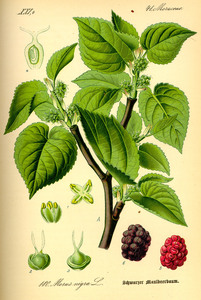
|
Black mulberry |
5-9
Full sun, Partial sun/shade
Moist
Light (sandy), Medium, Heavy (clay)
Deciduous
10.0
4.5
Perennial
Trees
Slow
Dye, Fiber, Lumber
true
Fruit, Shoots
Mulberry, Morus species
Schwarze maulbeere
Moraceae
Iran
Afghanistan, Albania, Algeria, Bermuda, Bulgaria, Canary Is., Cuba, Greece, India, Iraq, Italy, Kazakhstan, Kirgizstan, Kriti, Lebanon-Syria, Leeward Is., Libya, Madeira, Morocco, Puerto Rico, Romania, Spain, Tadzhikistan, Transcaucasus, Tunisia, Turkey, Turkmenistan, Uzbekistan, Vietnam, West Himalaya, Windward Is., Xinjiang
https://en.wikipedia.org/wiki/Morus_nigra
https://pfaf.org/User/Plant.aspx?LatinName=Morus nigra
https://powo.science.kew.org/taxon/urn:lsid:ipni.org:names:854688-1
|
The black mulberry (Morus nigra) is a species of mulberry native to southwestern Asia, including Iran, Afghanistan, and Pakistan. It is a small to medium-sized tree that grows to be about 20-30 feet tall and has a round, dense canopy. The leaves of the black mulberry are dark green and glossy on the top, and paler and slightly hairy on the bottom. The tree produces small, white flowers in the spring, which are followed by black, juicy fruits in the summer. The black mulberry is relatively fast-growing and can reach its full size in about 10-15 years. It prefers well-drained, fertile soil and full sun, but can tolerate partial shade. It is also winter hardy and can withstand temperatures down to about -10°F. The fruits of the black mulberry are edible and can be eaten fresh or used in jams, jellies, and other preserves. They can also be dried and stored for later use. The leaves of the black mulberry can be fed to silkworms, and the wood of the tree is strong and durable, making it suitable for a variety of uses. In addition to its edible fruits, the black mulberry has several other uses. Its leaves can be used as a natural fertilizer, and the tree can provide shade and wind protection in gardens and farms. The black mulberry is also a popular food source for birds and other wildlife. |
Show
Edit |
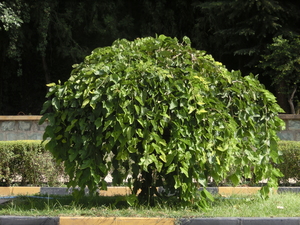
|
White mulberry |
3-9
Full sun, Partial sun/shade
Moist
Light (sandy), Medium, Heavy (clay)
Deciduous
18
13
Perennial
Trees
Medium
Biomass, Dye, Fiber, Animal feed, Wind breaker, Tannin, Lumber
true
Fruit, Inner bark, Leaves, Shoots
Common mulberry
Weiße Maulbeere
Moraceae
Angola, Benin, Cameroon, Central African Repu, Congo, Equatorial Guinea, Gabon, Ghana, Guinea, Guinea-Bissau, Ivory Coast, Kenya, Liberia, Mauritania, Namibia, Nigeria, Senegal, Sierra Leone, Tanzania, Uganda, Zaïre
https://en.wikipedia.org/wiki/Morus_alba
https://pfaf.org/User/Plant.aspx?LatinName=Morus alba
https://powo.science.kew.org/taxon/urn:lsid:ipni.org:names:547653-1
Weed potential
Manna, Tea
|
The white mulberry is a deciduous tree native to northern China, Korea, and Japan. It has large, heart-shaped leaves and small, white or pale pink flowers that grow in clusters. The tree can grow to be quite large, up to 50 feet tall, and it is fast-growing. White mulberry trees can be differentiated from other mulberry trees by their white, rather than dark purple, fruit. White mulberry trees prefer well-draining soil and full sun, but can tolerate partial shade. They are drought-tolerant and can thrive in a variety of soil types. In colder climates, they may need to be protected from frost during the winter months. The fruit of the white mulberry tree is edible and is often used to make jams, jellies, and wines. The fruit can be stored by freezing or canning. Young leaves can also be eaten. White mulberry trees are valued for their fast growth and ability to provide shade. They can be used for wind protection and as a ground cover. The leaves of the tree are sometimes used as animal feed. In some cultures, the bark of the white mulberry tree is used medicinally. Leaves are not frost resistant. |
Show
Edit |
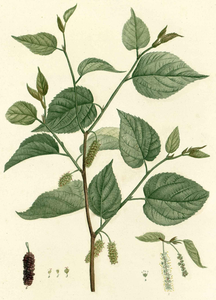
|
Red mulberry |
4-9
Full sun, Partial sun/shade
Moist
Light (sandy), Medium, Heavy (clay)
15.0
4.5
Perennial
Trees
true
Fruit, Leaves, Shoots
Common mulberry, white mulberry
Rote maulbeere
Moraceae
Alabama, Arkansas, Connecticut, District of Columbia, Florida, Georgia, Illinois, Indiana, Iowa, Kansas, Kentucky, Louisiana, Maryland, Massachusetts, Michigan, Minnesota, Mississippi, Missouri, Nebraska, New Jersey, New York, North Carolina, Ohio, Oklahoma, Ontario, Pennsylvania, Rhode I., South Carolina, Tennessee, Texas, Vermont, Virginia, West Virginia, Wisconsin
Bermuda, New Mexico, Turkey, Turkey-in-Europe
https://en.wikipedia.org/wiki/Morus_rubra
https://pfaf.org/User/Plant.aspx?LatinName=Morus rubra
https://powo.science.kew.org/taxon/urn:lsid:ipni.org:names:854710-1
1.5
Fiber, Lumber
|
The Red mulberry, Morus rubra, is native to the eastern United States and Canada. It is a deciduous tree that can grow to a height of up to 80 feet. The leaves are dark green and have a rough texture. The tree produces small, greenish-white flowers in the spring, which develop into clusters of red berries in the summer. The Red mulberry is often differentiated from other mulberry species by its smaller leaves and red berries. It prefers well-drained, moist soil and partial to full sun exposure. It is winter hardy and does not require any special care or maintenance. The fruit of the Red mulberry is edible and can be eaten fresh or used in cooking and baking. The berries can be stored in the refrigerator for up to a week. The tree also has a number of medicinal uses, including as a laxative and for treating sore throat and bronchitis. In terms of wildlife, the Red mulberry is a valuable food source for a variety of birds and mammals. Its fruit is a popular food source for birds such as robins, mockingbirds, and blue jays. The tree also provides habitat for birds and small mammals. |
Show
Edit |

|
Chili |
9-11
Annual, Perennial
Full sun
Moist
Light (sandy), Medium
60-90cm
Herbs
Fruit
Seed - direct sow, Seed - transplant
1 week after last frost
https://en.wikipedia.org/wiki/Bird%27s_eye_chili
6.0-6.5
80-85
40cm
Heart
24°c
7-21 days
Solanaceae
Guatemala, Mexico Central, Mexico Gulf, Mexico Northeast, Mexico Northwest, Mexico Southeast, Mexico Southwest
Alabama, Aldabra, Algeria, Andaman Is., Angola, Assam, Austria, Bahamas, Bangladesh, Belize, Benin, Bismarck Archipelago, Bolivia, Borneo, Botswana, Brazil North, Brazil Northeast, Bulgaria, Burundi, Cambodia, Cameroon, Canary Is., Cape Verde, Caroline Is., Cayman Is., Central African Repu, Chad, Colombia, Comoros, Congo, Cook Is., Costa Rica, Cuba, Djibouti, Dominican Republic, East Himalaya, Ecuador, El Salvador, Equatorial Guinea, Eritrea, Ethiopia, Fiji, Gabon, Galápagos, Gambia, Ghana, Gilbert Is., Greece, Guinea-Bissau, Gulf of Guinea Is., Guyana, Haiti, Honduras, India, Ivory Coast, Jawa, Kazakhstan, Kazan-retto, Kenya, Korea, Laos, Leeward Is., Line Is., Madagascar, Madeira, Maldives, Mali, Marianas, Marquesas, Marshall Is., Maryland, Mauritius, Morocco, Myanmar, Nepal, New Guinea, New South Wales, New York, Nicobar Is., Niger, Nigeria, Northern Provinces, Northern Territory, Oman, Pakistan, Panamá, Peru, Philippines, Puerto Rico, Queensland, Rodrigues, Réunion, Senegal, Sierra Leone, Society Is., Solomon Is., Somalia, South European Russi, Southwest Caribbean, Sri Lanka, Sulawesi, Suriname, Tadzhikistan, Tanzania, Togo, Trinidad-Tobago, Tuamotu, Tunisia, Turkey, Turkmenistan, Turks-Caicos Is., Uganda, Uzbekistan, Vanuatu, Venezuela, Vietnam, Wake I., West Himalaya, Windward Is., Zambia, Zaïre, Zimbabwe
4-12 weeks before last frost
https://powo.science.kew.org/taxon/urn:lsid:ipni.org:names:316944-2
|
Chili, also known as Capsicum annuum, is a flowering plant in the nightshade family Solanaceae. It is native to the Americas, where it has been cultivated for thousands of years. Though the scientific name hints at it being an annual plant, it can be grown perennially if you are in USDA hardiness zone 9-11. Chili plants typically grow to a height of 1-2 feet and have oval-shaped, glossy leaves. The flowers are small and white, and the fruit, which are commonly referred to as chili peppers, can vary in color and size. Chili peppers can be red, yellow, green, or purple and can be as small as a pea or as large as a banana. Chili plants prefer warm, sunny growing conditions and well-draining soil. To cultivate chili peppers successfully, gardeners will need to provide these conditions and also ensure that the plants receive enough water. Chili peppers are not winter hardy, so they will need to be brought indoors or grown in a greenhouse during the colder months. Chili peppers are edible and are commonly used in cooking to add heat and flavor to dishes. The fruits can be eaten fresh or dried, and they can also be ground into a powder to make chili powder. The leaves and stems of the plant are not typically eaten. In addition to their culinary uses, chili peppers have a number of other uses. They have been used medicinally to treat a variety of conditions, including toothaches and respiratory problems. Chili peppers can also be used as a natural insect repellent, and the plants can provide habitat and food for a variety of birds and insects. |
Show
Edit |